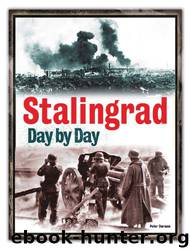Stalingrad: Day by Day by Jason Turner

Author:Jason Turner [Turner, Jason]
Language: eng
Format: epub
Tags: World War 2, Battles, Tactics, Weapons & Warfare
ISBN: 9780785828921
Amazon: 0785828923
Goodreads: 14902059
Publisher: Pen & Sword
Published: 2012-03-16T04:00:00+00:00
The tanks of both sides were very vulnerable in Stalingrad. This T-34 was knocked out at close range.
The swastika flies from a ruined building in Stalingrad, which acted as Friedrich Paulus’ field headquarters in October 1942.
German tactical problems
In the last week of September, Paulus launched his second attack on Stalingrad. He exchanged divisions with his northern flank and used the new units to renew the offensive. It pushed the Soviets back into the northern sector of Stalingrad, but casualties and ammunition expenditures were so high that Paulus called off the offensive. The Sixth Army did not begin its third offensive until October 14, when Paulus sent four divisions supported by armour to assist in taking the northern factory complexes. This created a crisis for the defenders, when on the second day the Germans captured the tractor factory and reached the Volga. Despite the heavy rain, snow and the mud, the attack made remarkable progress, capturing the ruins of several blocks of houses, the Red October Factory and some other burned-out hulks. But at the end of the month the attacks fizzled out from the high casualties and insufficient ammunition. Chuikov’s garrison had been reduced to two small pockets and the block ice in the Volga had created a logistical nightmare, but the Germans were spent. Paulus launched the fourth and final attack on November 11, based on the arrival of five engineer battalions. The attack advanced very slowly against tough resistance. It, too, expired after several days, and on the 19th the Soviets launched Operation Uranus, which would destroy the Sixth Army.
German Panzergrenadiers had never fought in a large city and had to rethink many of their methods. All German infantry loved the StuG because they could take cover behind the heavily armoured vehicle as it advanced and fired. It was a serious mistake, however, for the infantry to use tanks in the same manner as the StuG, because the Panzer III and IV tanks were too vulnerable to enemy fire. Instead, they were urged to advance with several tanks behind them, providing fire support.
Although tanks and Panzergrenadiers had been working together in combat since 1939, they had hardly ever seen each other on the battlefield. Putting tanks and armoured infantry in a small urban space consequently required a different, more intimate level of cooperation. The combined-arms team in such a scenario required a small number of tanks, armoured infantry and engineers. Rubble, narrow streets and bomb craters restricted the number of tanks that could operate effectively in such an area. German commanders were urged to examine the terrain beforehand, noting obstacles, cover and the enemy situation. An attack plan had to come from this orientation, reaching an understanding of who would do what. The tank commander, for example, had to enter the fight knowing how limited his vision would be and how dependent the tanks would be on the other branches.
As both sides fed more and more troops into the city during September, the city was blanketed by mass artillery barrages and aerial bombardment.
Download
This site does not store any files on its server. We only index and link to content provided by other sites. Please contact the content providers to delete copyright contents if any and email us, we'll remove relevant links or contents immediately.
| Africa | Americas |
| Arctic & Antarctica | Asia |
| Australia & Oceania | Europe |
| Middle East | Russia |
| United States | World |
| Ancient Civilizations | Military |
| Historical Study & Educational Resources |
The Radium Girls by Kate Moore(11967)
100 Deadly Skills by Clint Emerson(4876)
Rise and Kill First by Ronen Bergman(4739)
The Templars by Dan Jones(4654)
The Doomsday Machine by Daniel Ellsberg(4446)
The Rape of Nanking by Iris Chang(4165)
Killing England by Bill O'Reilly(3968)
Hitler in Los Angeles by Steven J. Ross(3923)
Stalin by Stephen Kotkin(3917)
12 Strong by Doug Stanton(3525)
Hitler's Monsters by Eric Kurlander(3289)
Blood and Sand by Alex Von Tunzelmann(3164)
The Code Book by Simon Singh(3124)
Darkest Hour by Anthony McCarten(3096)
The Art of War Visualized by Jessica Hagy(2972)
Hitler's Flying Saucers: A Guide to German Flying Discs of the Second World War by Stevens Henry(2730)
Babylon's Ark by Lawrence Anthony(2646)
The Second World Wars by Victor Davis Hanson(2502)
Tobruk by Peter Fitzsimons(2475)
